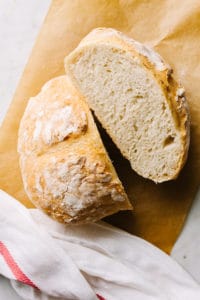ARTISAN BREAD RECIPE
Crispy crust on the outside, soft and tender on the inside, this artisan bread recipe with only 4 ingredients and no kneading required is SO easy to make and tastes amazing! Works great as pizza dough too. Recipe inspired by the book Artisan Bread in Five Minutes a Day
- Prep Time: 2 hours 30 min
- Cook Time: 30 min
- Total Time: 3 hours
- Yield: Makes 4 loaves 1x
- Category: Bread
- Method: bake
- Cuisine: American
- Diet: Vegan
Ingredients
Master Recipe (makes 4 small loaves):
- 3 cups lukewarm water
- 1 1/2 tablespoons instant or active dry yeast
- 1 1/2 tablespoons coarse salt
- 6 1/2 cups all-purpose flour
I used this halved recipe (makes 2 small loaves):
- 1 1/2 cups lukewarm water
- 1 packet instant or active dry yeast (about 2 1/4 teaspoons)
- 2 teaspoons himalayan salt
- 3 1/4 cups all-purpose flour
Instructions
MAKE THE DOUGH:
Mix: In a very large mixing bowl, combine the water, yeast, and salt. If adding herbs, now is a good time, use a teaspoon or so of your favorite herbs or double if using fresh. Add flour all at once and stir with a wooden spoon or mix with your fingers. Takes only a minute, if that. No need to knead, just mix. You just want everything combined with no streaks of flour left and you’re done.
Rise: Cover container with saran wrap (recommended) or a clean kitchen towel. Let the dough rise in a warm area with no draft. It may take anywhere from 2 to 4 hours, depending on the temperature (ideal temp is 75 – 85).
Separate: Once done, if making the master recipe, pull away 1/4 of the dough and refrigerate the rest to bake later. If making the halved recipe, pull away half of the dough. Store the unused dough covered tightly with plastic wrap or in a bowl covered tightly covered and keep in the refrigerator for up to 2 weeks. The longer it stores will enhance the flavor.
Shape: Lightly dust your hands and flat surface with flour or cornmeal, so it won’t stick. Take your dough and place it on the floured flat surface. Gently pull the sides of the dough toward the bottom, rotating the dough until you get a roundish shape with a smooth surface. Also, don’t worry if the bottom is a little bunched, it will flatten out upon the second rising.
Rest: Place your dough ball (boule) onto a flat surface lined with parchment paper (if not using parchment paper, place on a flat surface dusted with cornmeal or flour), and let it rest for at least 30 minutes. No need to cover it. If the dough has been refrigerated, it helps to let it rest a little more until it’s no longer chilled.
BAKE THE DOUGH:
Preheat the oven to 450 degrees F. Placing a cast iron skillet, pizza stone, roasting pan, or shallow fry pan in the oven to get it nice and hot (a baking sheet will be fine too). Let the oven preheat for 30 minutes.
Prep oven and dough: When ready to bake, place a rimmed cookie sheet or small pot with at least 1 cup of water on the bottom rack to steam – this will help the crust get nice and crispy, but it’s fine if you skip it. Line your baking vessel with parchment paper or lightly flour with cornmeal. Dust a little flour on top of your loaf, using a knife slash the top, about 1/4 inch deep, in a cross, tick tac toe, or scallop pattern (this helps the bread expand when baking while also giving it a rustic look).
Bake: Place prepped dough in center of baking vessel and place in the oven, center rack, for 30 – 40 minutes, until you get a nice brown crust. Carefully remove from oven, let cool a few minutes and enjoy!
Notes
To make pizza dough: Follow the steps to make the dough, if making the larger master recipe, use 1/4 of the dough and shape into a square or round pizza. Par-bake the dough for 7 – 10 minutes at 450 degrees F, carefully remove from oven, top with sauce and pizza topping and bake for another 10 – 15 minutes.
Gluten-free: Use a 1-to-1 gluten free flour blend containing xanthan gum. If it doesn’t contain xanthan gum, add 1 1/2 teaspoons to the master loaf recipe. No other changes are needed. Bread will form a hard crust and the center will be nice, but it will taste different and may not rise as much.
Using Grams: For those baking using weight instead of cups, here is a handy guide King Arthur’s Ingredient Weight Chart. Simply use the search filter to find the flour you are using.
Make larger loaves of bread. When using the master recipe, you can use 1/2 of the recipe to make a single larger loaf.
Find it online: https://simple-veganista.com/no-knead-artisan-bread-short-rise/
